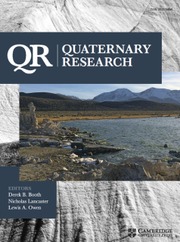No CrossRef data available.
Article contents
Holocene hydroclimate and dust activity, as reconstructed from the sediments of Lake Bayanchagan, on the northern margin of the East Asian summer monsoon
Published online by Cambridge University Press: 18 October 2023
Abstract
The sediments of closed-basin lakes on the margin of the East Asian summer monsoon (EASM) are valuable archives of past changes in hydroclimate and dust activity and thus potentially can help us to understand future climate changes. We present high-resolution, well-dated records of the grain size and carbonate mineralogy from Lake Bayanchagan, northern China, spanning the last 11.5 ka. Grain-size endmember (EM) analysis distinguished four EMs, each linked to different sediment transport processes. EM1 (0.4–0.6 μm) and EM3 (14–102 μm) reflect the strength of regional dust activity, whereas EM2 (1.3–31 μm) represents variations in local hydrodynamic conditions related to lake-level changes and EM4 (68–500 μm) is associated with local dust activity. Our results show that a high lake level and weakened dust activity occurred during 10–5.8 ka, as indicated by increased EM2 and decreased EM3, respectively. After 5.8 ka, EM2 decreased as the three other EMs increased, and dolomite appeared in the sediments while calcite decreased—indicating both a decline in lake level and strengthened dust activity. The fluctuations in lake level and dust activity are in good agreement with precipitation variations reconstructed from other records, which are in turn correlated to movement of the EASM rainfall belt, in response to temperature changes.
- Type
- Research Article
- Information
- Quaternary Research , Volume 120: Loess Environments: Generation, Transport, and Deposition , July 2024 , pp. 62 - 70
- Copyright
- Copyright © The Author(s), 2023. Published by Cambridge University Press on behalf of Quaternary Research Center



